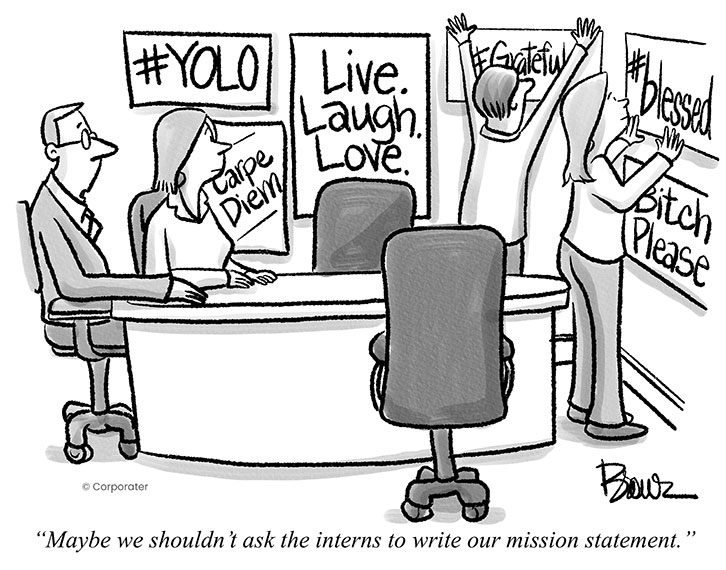
We live in a cultural time that is defined by many things, but unquestionably one of the guiding principles today is the notion that finding your true mission is vital should you hope to lead a happy and productive life. Open any bestselling book, listen to successful people in virtually any field, and their advice will be the same: Find your passion, your mission, and happiness and inner peace will surely follow. An hour before writing this, one of us heard retired female auto racing pioneer Danica Patrick issue this exact counsel. Or was it Richard Branson … or Mark Zuckerberg? You get the picture.
Strangely enough, as accepted as finding your mission is in our personal lives, it is universally derided in the organizational world. Bring up the topic of mission in the halls of your company and you’re as likely to be greeted by eye rolls and mentions of a Dilbert cartoon as you are with sincere interest and enthusiasm. But why is this the case? While many concepts we pursue in our personal lives would not translate in the organizational realm, mission does. It is every bit as important for companies as it is for individuals. David Packard, one of the co-founders of Hewlett-Packard, recognized that truth when he delivered this message to employees way back in 1960: “A group of people get together and exist as an institution that we call a company so they are able to accomplish something collectively that they could not accomplish separately — they make a contribution to society … do something which is of value.”i Inspirational stuff!
Ready to rethink the idea of mission? Great, let’s define the term. A mission statement describes the core purpose of the organization — why it exists. The mission examines the raison d’etre for the organization beyond simply increasing shareholder wealth, and reflects employees’ motivations for engaging in the company’s work. The mission attempts to capture the contribution and value that Mr. Packard so eloquently describes, illuminating the core purpose that draws us to our work and inspires our very best.
If you don’t have a mission statement, or you require a liberal dose of lemon Pledge to get the dust off your current mission, here are some tips to get you started on outlining yours.
- Ask “why” you exist
And not just once. Maybe three, four, or even five times, until you unearth why it is you exist. Your first round might yield responses such as, “To provide shareholders with a fair return on their investment,” or “To provide (insert product or service here) to our customers.” Yawn. Will those stale bromides get people bouncing out of bed in the morning? Not likely. Keep asking why until you discover what it is that really gets your juices flowing. - Write it for the long term
Strategies may change over time. In fact, they should evolve as circumstances in your operating environment dictate. The mission, however, should be written to stand the test of time. It should remain the bedrock of the organization, serving as the stake in the ground for all future decisions. - Make it easily understood and communicated
Simplicity reigns when it comes to mission statements. A compelling and memorable mission is one that reaches people on a visceral level, speaks to them and motivates them to serve the organization’s purpose. Forget the buzzwords, and put away the thesaurus for this exercise. Focus on honesty and authenticity.
Call us idealistic, but we believe David Packard’s words are true; people do want to make a difference. However, the global statistics on employee engagement are currently dismal to say the least. Our contention is that engagement is suffering not because people don’t like what they’re doing, but because they’ve lost sight of (or were never introduced in the first place) to why they’re doing it. A mission statement holds the promise of creating that line of sight and is a vital first step in ensuring all members of your team are actually rowing in the same direction.

